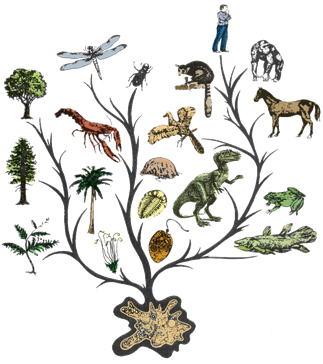
EVOLUTION AND
ADAPTIONS
Unit
Overview
In this unit, we will examine some
frequently asked questions concerning evolution in an attempt to clarify and
focus specifically what the Theory of Evolution is. This unit is not an attempt
to influence an individual’s right to believe any theory about creationism but
simply to reveal what the evolutionary theory of creation professes. We will
also examine the Theory of Adaptation, which shares some similar concepts with
evolution.
Unit Directions
Read the material and answer the test
questions at the conclusion of the unit. To further understand some of the
areas go on line to the WGBH site or search PBS television for Evolution.
These sites will enable you to click on various film clips to provide support
material for each area of the article.
The Basics
1. What is evolution?
Biological
evolution refers to the cumulative changes that occur in a population over
time. These changes are produced at the genetic level as organisms' genes
mutate and/or recombine in different ways during reproduction and are passed on
to future generations. Sometimes, individuals inherit new characteristics that
give them a survival and reproductive advantage in their local environments;
these characteristics tend to increase in frequency in the population, while
those that are disadvantageous decrease in frequency. This process of
differential survival and reproduction is known as natural selection. Non-genetic changes that occur during an
organism's life span, such as increases in muscle mass due to exercise and
diet, cannot be passed on to the next generation and are not examples of
evolution.
2. Isn't evolution just a theory that remains
unproven?
In
science, a theory is a rigorously tested statement of general principles that
explains observable and recorded aspects of the world. A scientific theory,
therefore, describes a higher level of understanding that ties
"facts" together. A scientific theory stands until proven wrong, but
it is never proven correct. The Darwinian theory of evolution has withstood the
test of time and thousands of scientific experiments; nothing has disproved it
since Darwin first proposed it more than 150 years ago. Indeed, many scientific
advances, in a range of scientific disciplines including physics, geology,
chemistry, and molecular biology, have supported, refined, and expanded
evolutionary theory far beyond anything Darwin could have imagined.
![]() Introduction
to Charles Darwin's Theory of Evolution (00:54)
Introduction
to Charles Darwin's Theory of Evolution (00:54)
3. Are all species related?
Yes.
Just as the tree of life illustrates, all organisms, both living and extinct,
are related. Every branch of the tree represents a species, and every fork
separating one species from another represents the common ancestor shared by
these species. While the tree's countless forks and far-reaching branches
clearly show that relatedness among species varies greatly, it is also easy to
see that every pair of species share a common ancestor from some point in evolutionary
history. For example, scientists estimate that the common ancestor shared by
humans and chimpanzees lived some five to eight million years ago. Humans and
bacteria obviously share a much more distant common ancestor, but our
relationship to these single-celled organisms is no less real. Indeed, DNA
analyses show that although humans share far more genetic material with our
fellow primates than we do with single-celled organisms, we still have more
than 200 genes in common with bacteria.
It is important
to realize that describing organisms as relatives does not mean that one of
those organisms is an ancestor of the other or, for that matter, that any
living species is the ancestor of any other living species. A person may be
related to blood relatives, such as cousins, aunts, and uncles, because he
shares with them one or more common ancestors, such as a grandparent, or
great-grandparent. However, those cousins, aunts, and uncles are not her
ancestors. In the same way, humans and other living primates are related, but
none of these living relatives is a human ancestor.
For
additional information on the tree of life, click on the following PDF File: Tree of Life PDF File
4. What is a species?
Members of
one species do not normally interbreed with members of other species in nature.
Sometimes, members of different species, such as lions and tigers, can
interbreed if kept together in captivity. But in nature, geographic isolation
and differences in behavior, such as choice of habitat, keep these sorts of
closely related animal species apart. Similarly, closely related species of
plants can sometimes be hybridized by horticulturists, but these hybrids are
rarely found in nature. A species, then, is defined by science as a group of
interbreeding or potentially interbreeding populations that is reproductively
isolated from other such groups.
5. What do genes have to do with evolution?
Genes
are the portions of an organism's DNA that carry the code responsible for
building that organism in a very specific way. Genes — and, thus, the traits
they code for — are passed from parent to offspring. From generation to
generation, well-understood molecular mechanisms reshuffle, duplicate, and
alter genes in a way that produces genetic variation. This variation is the raw
material for evolution.
6. What role does sex play in evolution?
Sexual
reproduction allows an organism to combine half of its genes with half of another
individual's genes, which means new combinations of genes are produced every
generation. In addition, when eggs and sperm are produced, genetic material is
shuffled and recombined in ways that produce new combinations of genes. Sexual
reproduction, therefore, increases genetic variation, which increases the raw
material on which natural selection operates. Genetic variation within a
species, also known as genetic diversity, increases a species' opportunity for
change over successive generations.
7. Is evolution a random process?
Evolution
is not a random process. The genetic variation on which natural selection acts
may occur randomly, but natural selection itself is not random at all. The
survival and reproductive success of an individual is directly related to the
ways its inherited traits function in the context of its local environment.
Whether or not an individual survives and reproduces depends on whether it has
genes that produce traits that are well adapted to its environment.
![]() The Proliferation of Species (02:33)
The Proliferation of Species (02:33)
8. Are evolution and "survival of the
fittest" the same thing?
Evolution
and "survival of the fittest" is not the same thing. Evolution refers
to the cumulative changes in a population or species through time. "Survival of the fittest" is a popular
term that refers to the process of natural selection, a mechanism that drives
evolutionary change. Natural selection works by giving individuals who are
better adapted to a given set of environmental conditions an advantage over
those that are not as well adapted. Survival of the fittest usually makes one
think of the biggest, strongest, or smartest individuals being the winners, but
in a biological sense, evolutionary fitness refers to the ability to survive
and reproduce in a particular environment. Popular interpretations of
"survival of the fittest" typically ignore the importance of both
reproduction and cooperation. To survive but not pass on one's genes to the
next generation is to be biologically unfit. And many organisms are the "fittest"
because they cooperate with other organisms, rather than competing with them.
9. How does natural selection work?
In the
process of natural selection, individuals in a population who are well-adapted
to a particular set of environmental conditions have an advantage over those
who are not so well adapted. The advantage comes in the form of survival and
reproductive success. For example, those individuals who are better able to
find and use a food resource will, on average, live longer and produce more
offspring than those who are less successful at finding food. Inherited traits
that increase individuals' fitness are then passed to their offspring, thus
giving the offspring the same advantage.
10. How do organisms evolve?
Individual
organisms don't evolve. Populations evolve. Because individuals in a population
vary, some in the population are better able to survive and reproduce given a
particular set of environmental conditions. These individuals generally survive
and produce more offspring, thus passing their advantageous traits on to the
next generation. Over time, the population changes.
11. Does evolution prove there is no God?
No. Many
people, from evolutionary biologists to important religious figures like Pope
John Paul II, contend that the time-tested theory of evolution does not refute
the presence of God. They acknowledge that evolution is the description of a
process that governs the development of life on Earth. Like other scientific
theories, including Copernican theory, atomic theory, and the germ theory of
disease, evolution deals only with objects, events, and processes in the
material world. Science has nothing to say one way or the other about the
existence of God or about people's spiritual beliefs.
Adaptations
Adaptation
is a theory that shares similar ideas with evolution, but it is less
controversial. An adaptation is an
adjustment to the environment. Any
characteristic that helps an animal to survive is considered an adaptation. Evolution focuses on all the changes that
happen through time. Adaptation looks at
the changes happening in one species during a time period or major event. There
are many different types of adaptations, they can be behavioral, physical, and
even the type of diet they have can be considered an adaptation. Again Darwin was a major part in discovering
these changes in animals. He was
studying in the Galapagos Island from 1831 – 1836. He noticed that on each island the finches’
beaks were different sizes and shapes.
The beaks ranged from large round beak to tiny pointed beaks. Looking at the picture below, why do you
think they are different?
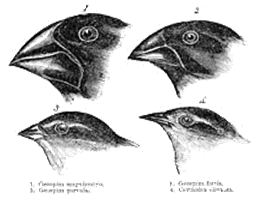
First
think, “What is the beak mostly used for?”
That would be communication and eating food. So Darwin observed that food that was readily
available on each island was different, although the islands were quite
similar.
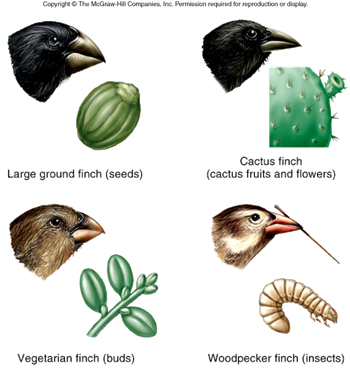
Finches
with larger beaks would survive better on an island with seeds better than on
an island with many cacti. On all the
islands there was not just one type of finch.
All beaks sizes were on each island, however, natural selection had its
effect on each island.
This is on example of adaptation concerning diet. If an animal is an herbivore, carnivore, or an omnivore that is also considered a diet adaptation. Food is a basic need of all living things, along with water, shelter, space or carrying capacity, and waste disposal. As mentioned many times, any characteristic that helps and organism obtain their basic needs is an adaptation.
Coloring
There
are many different types of physical adaptations; they can be anything to do
with any parts of the body or coloring.
Coloring is a major one. Animals
that use coloring to blend into their surroundings are camouflage. A white rabbit would not survive in a wooded area
because it would be easily seen. A white
rabbit would have a higher survival rate in an area that has snow for most of
the year.
A
fantastic example of animals adapting to their environment and changing colors
is the peppered moths. In England, the
white moth with black spots was pretty common.
The moths called home, trees with light colored bark and mosses.
Once
the Industrial Revolution began in England less and less of these moths were
seen. These moths were not just
disappearing, they were changing color.
Darwin’s words of survival of the fittest were being seen. Now that soot
from all the new industries was covering trees, white moths were more easily
seen by their predators; therefore darker moths had a better chance of
surviving. The number of black peppered moths began to increase. This change can now be seen in reverse. Industries have standards that keep the air
cleaner, so the white barked trees are staying white. So the peppered moths are returning to their
original color.
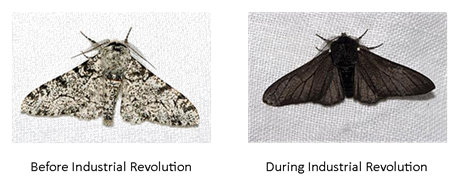
Warning
color is another way color is used for defense.
The most commonly known animal that uses warning color is the poison dart frog. The bright colors tell predators they are poisonous.
Many animals steal coloring or patterns from other animals. Mimicry
is when an animal looks, sounds, or acts like another animal to fool other
animals into thinking it is dangerous or poisonous. The Owl Butterfly pictured below has the same
coloring and eye patterns as the owl.
From a distance in a tree it would be difficult to tell that it is not
an owl.
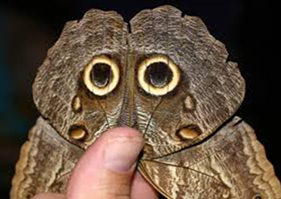
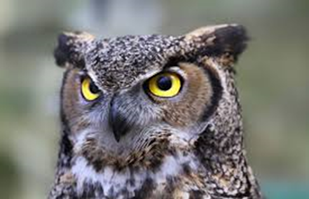
Behavior
Animals
use certain behaviors to help them to survive.
These are common behaviors that you many not of thought of as
adaptations. Schooling or herding is when animals travel and stay in large
numbers. When traveling in groups there
are more eyes, ears, and bodies to detect and fend off danger. Being nocturnal
is a behavioral adaptation. To be
awake during the night, animals need special eyes to see clearly. The majority of nocturnal animals have large
eyes with large pupils. This allows the
eyes to take in more light, which makes the darkness clearer.
Hibernation is when an animal will go into a deep sleep, usually
during the colder months. Animals go
into hibernation to conserve energy because their food source is scarce during
a certain time of year. Right before
hibernation animals eat large amounts of food.
That food builds up fat which is where their energy is stored. Once in hibernation, the animal’s heart rate
is slowed and its body temperature is dropped.
As they sleep, their body uses the energy that is in the fat. As a result they will lose most of the weight
they gained before hibernation. Migration is when animal travel to
another area. This is mostly seen in the
colder months. Once it gets cold, food
supply is low, so some animals have to travel to a warmer climate. Some animals travel thousands of miles to
reach their destination.
 Now answer
questions 1 through 25.
Now answer
questions 1 through 25.